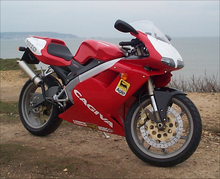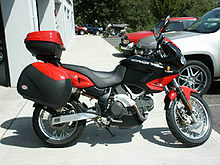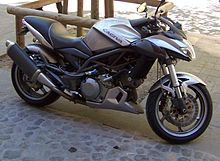Cagiva
Cagiva is an Italian motorcycle brand that was founded in 1978 by the brothers Gianfranco and Claudio Castiglioni after the family took over the Aermacchi plant in Varese from Harley-Davidson . The company's name was formed as an acronym from the name of the father of the Castiglioni brothers and the company's headquarters, Castiglioni Giovanni Varese.
history
Cagiva initially continued to manufacture the small two-stroke motorcycles built by Aermacchi. Later they also worked on in-house developments with their own design , the engine technology of which came from Ducati . In 1985, the state-owned VM group took over the Ducati company, which had got into an economic crisis and only played a minor role as a motorcycle manufacturer. Ducati was originally only intended to serve as an engine supplier, but later both companies benefited from this merger. The sales of motorcycles of both companies could be increased from almost 8,000 units in 1980 to over 50,000 units in 1985.
The first joint projects in 1984 were the Cagiva Elefant 650 and the Cagiva Alazzurra 650, each with Ducati engines. While the Alazzurra was still a road machine in the footsteps of Aermacchi, the Elefant, which was later also available with other cubic capacities and in further developments until 1995, was there as a large enduro, with the aim of being guided off-road. The high points in racing were the beginning of the 1990s, when the Elefant 900 Lucky Explorer celebrated multiple successes in the Paris-Dakar rally. But Cagiva was not unsuccessful on the racetrack either. In 1995, Cagiva also said goodbye to the Moto-GP after they reached third place that year.
In 1987 the motorcycle division of the Swedish engine manufacturer Husqvarna found its new home in the Castiglioni Group in Varese, thus underlining the ambitions of Cagiva to be successful in enduro sports. In 1986, the Moto Morini brand was also taken over by the Castiglionis to cover the chopper and tourer market. Without success, the production of Moto Morini was stopped in 1991 and the brand disappeared from the market. The rights to the brand name were resold in 1999 to the company Motori Franco Morini , which resumed production. In 1992 Cagiva bought the naming rights to MV Agusta , whose motorcycle division had been discontinued shortly before. The brand should make a big comeback in the late 1990s. Cagiva also operated a joint venture company with the Czech company Česká zbrojovka (Stracknitz) , which had also been very successful in enduro and other competitions until then. In 1997, however, the motorcycle production of this well-known brand was stopped.
At the end of the 1990s, Cagiva ran into economic difficulties and the Ducati brand had to be sold. So there were problems with the engine supply and alternatives had to be found, which were found in cooperation with Suzuki . MV Agusta Holding, which in addition to Cagiva also holds the MV Agusta brand , has been owned by the Castiglioni family to only 37.25% since the end of 2004, and 57.75% by the Asian car manufacturer Proton. 2% is held by Massimo Tamburini (also stake in Bimota ) and 3% by the Husqvarna group, which is now part of Electrolux . The associated capital increase of 70 million euros is intended to secure the future of the Cagiva brand.
In March 2006 a majority stake in MV Agusta Motor SpA was acquired. The share capital increased by 15 million. The investment company GEVI SpA from Genoa has acquired the majority stake in MV Agusta Motor SpA from the Malaysian group Proton. The relevant agreement was signed in Varese on March 1, 2006 and led, among other things, to an injection of new funds of 15 million euros and thus to an increase in the company's share capital to 72 million euros. With this regrouping, GEVI now holds 65% of the total share capital. Thanks to this transaction - made possible with the support of the banks - the MV Agusta group now has further development potential for the company, which was able to record an increase in earnings of around 20% in 2005.
In January 2007, after just over a year, the Malaysian car manufacturer Proton said goodbye to the motorcycle scene and surrendered its stake in the traditional Italian brand MV Agusta to the Italian GEVI SpA for one euro. At the end of 2003, Proton had acquired 57.75 percent of MV with the other brands Husqvarna and Cagiva for around 70 million euros, but in the course of 2004 it got itself deeply into crisis: Because Malaysia also opened up to foreign car manufacturers, the market share fell of the semi-state group there to only 30 percent. This resulted in a change of the entire management; the new bosses changed strategy and first questioned Proton's European holdings, which include MV Agusta. GEVI will take over the debts of MV Agusta in the amount of 106.94 million euros. Furthermore, the buyer will carry the required working capital of 32.5 million euros, according to Proton in a statement.
In 2007 BMW took over the subsidiary Husqvarna Motorcycles . In 2008, the MV-Agusta Group with the brands MV Agusta and Cagiva was taken over by Harley-Davidson . Claudio Castiglioni bought the company back for a symbolic euro for the second time in the summer of 2010 after the US manufacturer Harley-Davidson itself got into economic difficulties.
Castiglioni died of cancer on August 17, 2011 at the age of 64, at which time he had already transferred the management of the MV Agusta Group to his son Giovanni.
Models
athlete
- Mito 125 (1989-2011)
- Freccia C9
- Freccia C10
- Freccia C12
- S2 / Aletta Oro 125
- Mito
- N1 / Planet 125
Sports tourer / all-rounder
- Blues 125
- SST 125/250/350
- Roadster 125/250
- Raptor 125
R2 engine
- River 500
- River 600
V2 engine
- Alazzurra 350 (1985)
- Alazzurra 400 (1986)
- Alazzurra 650 (1985-1986)
- V2 engine from Suzuki SV650 , 645 cm³, 54 kW at 9000 min −1
- Raptor 650 (2001-2007) → Raptor 650 ie
- V-Raptor 650 (2001-2004)
- V2 engine from Suzuki TL1000 , 998 cm³, 83 kW at 8500 min −1
- Raptor 1000 (2000-2005)
- V-Raptor 1000 (2000-2004)
- Xtra-Raptor 1000 (2002-2005)
Enduros / travel enduros
Single cylinder engines
- SXT (125, 175, 250 and 350 cm³, 1975–1984)
- Tamanaco 125
- Aletta Rossa (125, 250 and 350 cm³)
- T4 350
- T4 500E
- Elefant 125 (1983–1986)
- Elephant 200
- Canyon 500 (single cylinder, 498 cm, 29 kW at 6500 min -1 , have been also available with a 25 kW)
- Canyon 600
V2 engines
- Elefant 350 (1985–1988)
- Elefant 400 (1985–1988)
- Elefant 650 (1985–1988)
- Elefant 750 (1987–1990) → Elefant 750 ac (1994–1996)
- Cagiva Azzalin Elefant 900 Paris Dakar → Elefant 900 ie Lucky Explorer (1990–1991) → Elefant 900 ie GT (1991–1992) → Elefant 900 ac (1993–1996)
- Gran Canyon 900 (1998-2000)
- V2 engine from Suzuki TL1000 , 998 cm³, 73 kW at 8500 min −1
- Navigator 1000 (2000-2006)
Supermoto
- Super City 125
- Super City 70
- Super City 50
Motocross
- W8 125
- W12 350
- W16 600
- WMX 125
- WMX 250
- WMX 200 ATV
Design studies
- Mito 500
- Raptor X3
Mini Moke

In 1990, Cagiva bought the manufacturing rights for the Mini Moke from MG Rover Group in order to manufacture it in Portugal from 1990 to 1993. The machines were brought to Bologna ( Italy ); The plan was to resume production there in 1995, but that never happened.
Web links
- Official website (Italian, English)
- German website





